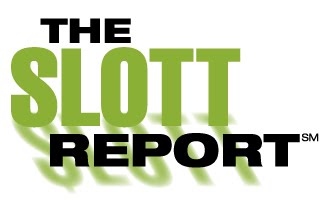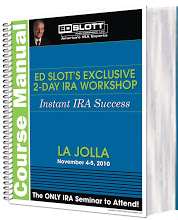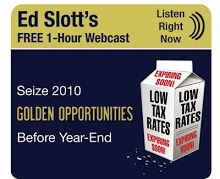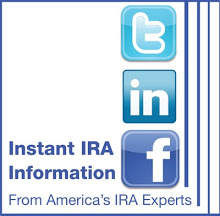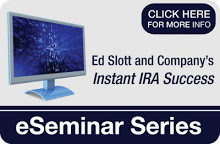Memorial Day weekend is upon us...well almost. We don't mean to jump the gun. Here are this week's questions and answers from
The Slott Report Mailbag.1.
Hello,
My husband has a ROTH account that has been open for 5 years this year. He is currently 58.
He wants to convert an IRA account to a new/different ROTH account with a different investment company. Is EACH Roth account subject to its own 5-year requirement before he can withdraw without penalty (once he is 59 1/2, of course. ) Once he reaches age 59 1/2, will he be able to withdraw from either ROTH without penalty, or will each Roth separately need to have been opened for 5 years?
Thanks!
Answer:Each IRA will have it's own 5 year holding period.
Once a Roth IRA owner attains age 59 1/2 they can always take out their basis (the amount put in) without penalty. If they take any amount above their basis a penalty will apply in the first 5 years.
2.
Hello my name is Angela,
I am currently converting my traditional IRA into a ROTH. The trust company is telling me that the taxes owed are required to come from the Traditional IRA account. I do not want this to happen. I would like to pay the taxes out of my personal checking account to keep purchasing power in the ROTH.
Is this possible?
Also, for the 1st time in 24 years I showed a loss on my taxes in 2008. I plan to amend my 2008 taxes and pay the taxes on the conversion for 2008. I was told this is possible and since I showed a loss, that this was a really good time to do this.
My current IRA was created when I did a direct roll over from a QRP years ago. I then rolled my 401k into a traditional when that 401k was terminated. I have since combined both into the same traditional.
Can this cause me any problems in the future?
Furthermore, is there any way for me to save on the amount of taxes it will cost me to convert. The total estimated conversion for me is 57,000 and the total for my spouse is 97,000. We are doing this to purchase income producing real-estate in a flex Roth. We anticipate selling the real-estate for a substantial profit in the next 2 years.
This is the main reason for the conversion.
Patiently awaiting your response,
Angela Bertone
Answer:I would suggest you talk to someone else (perhaps higher up) at that institution. Paying the taxes due from other assets is generally a smart thing to do.
If you converted in 2008 that amount should be included in your 2008 return. The actual taxes due on the conversion would have had to be paid by 4/15/09, assuming no extensions. Most qualified retirement plans and other retirement plans such as IRAs are now portable. You can combine most of them into a single IRA.
I would suggest consulting your accountant or tax advisor about saving taxes. They would know what if anything can be done in your personal situation.
3.
Dear Ed and Company,
I have a SEP-IRA established for my business. I have every intention of continuing to work beyond 70.5. Can I delay RMD from that account so long as I continue to work, and if so, what notification do I have to provide the IRA in that regard?
Thanks so much!
John Wellfare, Fremont, CA
Answer:At age 70 1/2 you must commence taking required minimum distributions from your SEP-IRA. A SEP-IRA is treated like any other traditional IRA.
4.
Form 5305-A says that when the depositor dies after the RBD and the beneficiary is not the spouse, "the remaining interest will be distributed over the beneficiary's remaining life expectancy..." (emphasis added). See 5305-A, Article IV(3)(a)(ii). I find no language in the IRS form that permits accelerated distributions, even though it is commonly understood that distributions may be made more rapidly. The section does not say "over a period not longer than" as in Article IV(2)(b). Do you see a problem with the form?
Sincerely,
Sean K. Mangan
Answer:Reading further on in Article IV, section 5 describes the minimum amount that must be distributed each year, 5(b) applies to distributions to non-spouse beneficiaries. There is nothing in the document that says that a beneficiary is prohibited from taking more than the minimum and by using the word "minimum" the document is indicating that amounts over the minimum can be taken. In addition, Article IV starts out by saying that the Article "shall" comply with §408(a)(6) which in turn refers you to §401(a)(9) which are the distribution rules for employer plans. The easiest way to get to an answer is to remember that as a general rule, whatever is not expressly prohibited, is allowed.
--By IRA Technical Consultant Marvin Rotenberg; compiled by Jared Trexler
------------------------------------------------------------
Comment, Question, Discussion Topic on your mind? Click on the
Blue Comment Link below and leave your thoughts then check back to see what other consumers and advisors think.
